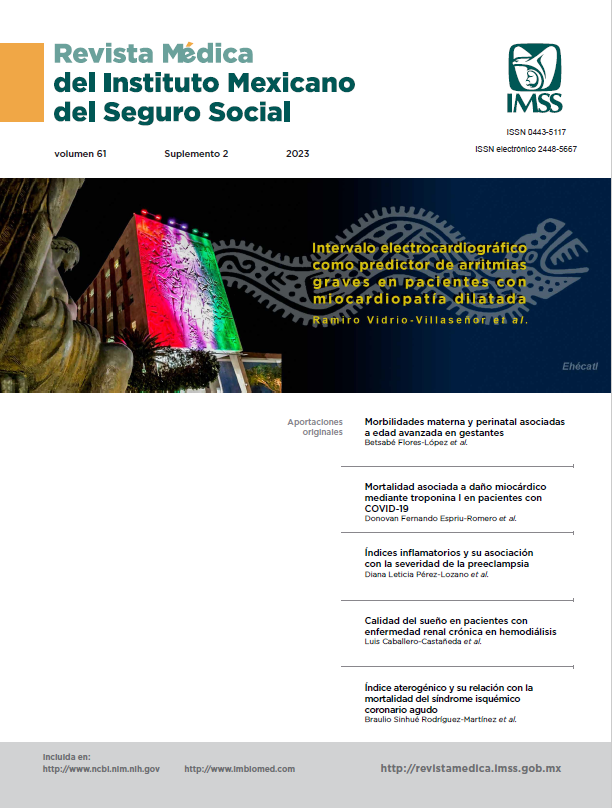Systolic blood pressure reduction in patients with intracranial hemorrhage and functional prognosis”
Main Article Content
Keywords
Arterial Pressure, Cerebrovascular Stroke, Prognosis, Hypertensive, Intracranial Hemorrhage, Hypertension
Abstract
Background: Acute intracerebral hemorrhage affects annually more than 1 million people worldwide. Chronic systemic arterial hypertension is the most important modifiable risk factor for spontaneous intracerebral hemorrhage.
Objective: To determine the relationship between the decrease in systolic blood pressure (SBP) in patients with intracranial hemorrhage and their short-term functional prognosis. Material and methods: Observational, longitudinal, prospective study in patients with intraparenchymal hemorrhage secondary to hypertensive dyscontrol, older than 18 years, of both sexes. Blood pressure was recorded at admission, every hour during the first 6 hours and every two hours from 8 to 24 hours after admission. Functionality was assessed using the modified Rankin scale at admission, at 6 and 24 hours after admission.
Results: 58 patients were included, in whom the reduction of systolic blood pressure at admission was 17.04% and at 24 hours was 31.3 mm Hg; the mean systolic blood pressure was 183.62 mm Hg as opposed to 152.3 mm Hg at discharge (p < 0.001).
Conclusions: In the first 6 hours, reduction in ASR is significantly associated with hospital outcome in patients with intracranial hemorrhage. A linear association was observed with improvement and favorable functional prognosis as measured by the modified Rankin scale.
References
Kissela B. “Ataque Cerebral”. Estados Unidos: Universidad de Cincinnati; 1993-1994, 1999- 2005.
Qureshi AI, Huang W, Lobanova I, Barsan WG, Hanley DF, Hsu CY, Lin CL, Silbergleit R, Steiner T, Suarez JI, Toyoda K, Yamamoto H; for ATACH-II trial investigators. Outcomes of Intensive Systolic Blood Pressure Reduction in Patients With Intracerebral Hemorrhage and Excessively High Initial Systolic Blood Pressure: Post Hoc Analysis of a Randomized Clinical Trial. JAMA Neurol. 2020 Sep 8;77(11):1–11.
Cruz C, Calleja-Castillo JM, Moreno-Macías H, Parra-Cabrera MDS, y Hernández-Girón C. Long-term survival and related prognostic factors with first ever ischhemic and hemorrhagic stroke, among Mexican patients. J Neurol Sci. 2017; 381 Supp :406-407. doi:10.1016/j.jns.2017.08.3360
Divani AA, Liu X, Petersen A, Lattanzi S, Anderson CS, Ziai W, Torbey MT, Moullaali TJ, James ML, Jafarli A, Mayer SA, Suarez JI, Hemphill JC, Di Napoli M. The Magnitude of Blood Pressure Reduction Predicts Poor In-Hospital Outcome in Acute Intracerebral Hemorrhage. Neurocrit Care. 2020;33(2):389-98.
NINDS ICH workshop participants. Priorities for clinical research in intracerebral hemorrhage: report from a national institute of neurological disorders and stroke workshop. Stroke. 2005;36:23-41.
Hillis AE, Tippett DC. Stroke Recovery: Surprising Influences and Residual Consequences. Advances in Medicine. 2014; 2014: 378263. doi: 10.1155/2014/378263.
Lopez A, Mathers C, Ezzati M, et al. Global and regional burden of disease and risk factors, 2001: systematic analysis of population health data. Lancet. 2006;367:1747-57.
Strong K, Mathers C, Bonita R. Preventing stroke: saving lives around the world. Lancet Neurol. 2007;6:182-87
Anderson, C. S., Heeley, E., Huang, Y., Wang, J., Stapf, C., Delcourt, C., ... & Hata, J. (2013). Rapid blood-pressure lowering in patients with acute intracerebral hemorrhage. N Engl J Med, 368, 2355-2365.
Mendelow A, Gregson B, Fernandez H, Murray GD. Early surgery versus initial conservative treatment in patients with spontaneous supratentorial intracerebral haematomas in the international surgical trial in intracerebral haemorrhage (STICH): a randomized trial. Lancet. 2005;365:387-97.
Instituto Mexicano del Seguro Social. Guía de práctica clínica Diagnóstico y tratamiento temprano de la enfermedad vascular cerebral isquémica en el segundo y tercer nivel de atención. Ciudad de México: IMSS; 16 de marzo de 2017.
World Health Organization. The global burden of disease: 2013 update. NY: WHO; 2013.
Feigin VL. Stroke in devolping countries: can the epidemic be stopped and outcomes improved? Lancet Neurol 2007; 6:94-97.
Bladin C, Alexandrov A, Bellavance A, Bonstein N, Chambers B, Coté R, et al. Seizures after stroke. A prospective multicenter. Arch Neurol. 2000; 57(11):1617-1622.
Almenkerk S, Smalbrugge M, Depla M, Eefsting J, Hertogh C. What predicts a poor outcome in older stroke survivors? A systematic review of the literature. Disabil Rehabil. 2013; 35(21): 1774– 1782.
Chiquete E, Ruíz J, Murillo B, et al. Mortalidad por enfermedad vascular cerebral en México, 2000-2008: Una exhortación a la acción. Rev Mex Neuroci. 2016;12:235-41.
Qureshi A, Tuhrim S, Broderick J, Batjer H, Hondo H, Hanley D. Spontaneous intracerebral hemorrhage. N Engl J Med. 2001;344:1450-60.
Láinez J, Pareja A. The medical treatment of intracerebral hemorrhage. Rev Neurol. 2000;31:174-9.
Ruiz J, Colorado H, Loy M, et al. Diagnosis and treatment of intracerebral hemorrhage. Rev Invest Clin. 2002;54:275-80.
Grysiewicz R, Thomas K, Pandey D. Epidemiology of ischemic and hemorrhagic stroke: incidence, prevalence, mortality and risk factors. Neurol Clin. 2008;26:871-95.
Ruiz-Sandoval JL, Chiquete E, Garate-Carrillo A, et al. Spontaneous intracerebral hemorrhage in Mexico: results from a multicenter nationwide hospital-based registry on cerebrovascular disease (RENAMEVASC). Rev Neurol. 2011;16(53):705-12.
Tsivgoulis G, Katsanos AH, Butcher KS, Boviatsis E, Triantafyllou N, Rizos I, Alexandrov AV. Intensive blood pressure reduction in acute intracerebral hemorrhage: a meta-analysis. Neurology. 2014 Oct 21;83(17):1523-9.


